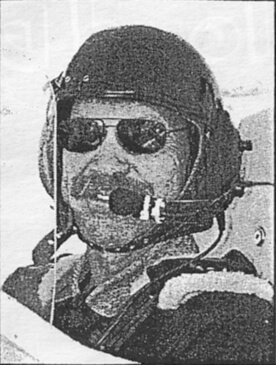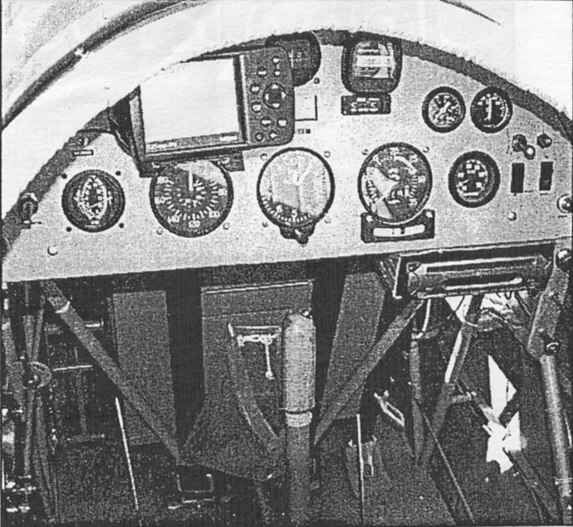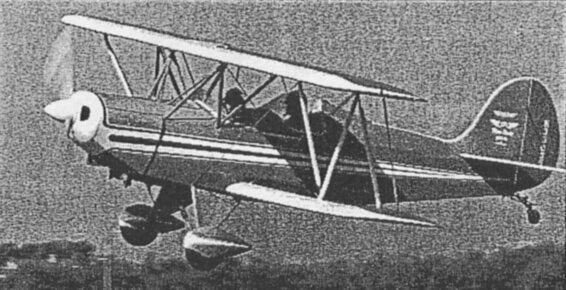Story and Photos by Chuck Stewart
John Proctor flew a Cessan 185 around Russia in 1991 and then wrote about it in the book “Viktor, Vodka and Raw Fish.”
In 1995-’96, he and his former wife Joyce traveled the world in a magnificently outfitted Grumman HU-16C Albatross amphibian, an odyssey documented in the video”The Boat In The Sky.”

Proctor, 58, who splits his time between homes in Roseburg, Ore. and Henderson, Nev., is writing a book about his aerial adventures in the Albatross. It’s working title is “To Hell and Back in a Flying Boat.”
His airplane of choice nowadays is far from a flying RV – it’s a sky-blue Hatz C-1B biplane. He acquired it earlier this year after seeing it advertised on a bulletin board at his home airport.
It was built from plans by Irving Siewert of Canon City, Colo. in 1990. After the test time was flown off, it was delivered to its owner: Ron Bertly of Ashlind, Ore.
Bartley put only 179 hours on it during the 14 years he had it. Since Proctor knew the plane’s history, he said he didn’t hesitate to buy it.
Designed by John Hatz of Merrill, Wisc., the Hatz is a handsome, mid-sized bipe. It’s 19 feet long 7.9 feet high and has a 25.35-foot wingspan with 178 square feet of area.

It weights 960 pounds empty and grosses out at around 1,400 lbs. Powered by a 135-hp Lycoming O-290D, it cruises at 105 mph and stalls at 46 mph.
“It’s fully aerobatic and has the flight characteristics of a typical biplane its site,” said Proctor.
“It was inspired by the Great Lakes, with which it is often mistaken,” he added.
One of its unique features is the covering material on the wings: Hypotech. According to Proctor, it’s made in Canada and is glued directly to the wooden ribs and stringers, eliminating the use of rib-stitching and tape.
“It’s also got a CD player, stereo and Val 760-channel radio and intercom made by a company in Salem, Ore.,” Proctor added. He’s also considering installing four video cameras to record his escapades and — big surprise — a set of 1,200-pound amphibious floats.
Other Battles
He’s also fighting and winning a battle with cancer that had him on the ropes a couple years ago. While the aviation rumor mill spread the word on that part of his story quite well, it failed to followup with the happy ending.
“Like Mark Twain, rumors of my death have been greatly exaggerated,” joked Proctor. “I knew I had a problem when a guy I met in Ardmore, Okla. was shocked to see me because he’d heard I was dead.”
Far from it. In fact, Proctor runs J.P. Flying Service in Roseburg and is doing more flying these days than he has in a long time.
“Flying is my life right now,” he declared. Part of that flying is volunteer work for the Bureau of Land Management, ‘Fish & Game Commission and Sheriff’s Dept. in Oregon.
JOHN PROCTOR
Depending on the mission, he uses either his C-185 or Piper PA-18 Super Cub. The latter is equipped with 31-inch Alaska bush wheels that make any surface a runway but slow the plane down by nine mph, he said.
During his infrequent downtime, he’s working on a souped-up Starduster with neighbor Steve Wolf, the man behind Delmar Benjamin’s Gee Bee replica. It will have a 360-hp Vedenyev Ml4P radial engine and amphibious floats.

Hence The Hatz
With his Albatross sold to a trio of Canadians in Victoria, BC, Proctor was in the mood for an old-fashioned cross-country flying adventure. Having proved its mettle on a flight over the Cascade Mountains at night, the Hatz was his baby.
“I wanted to reconnect with my flying past,” explained Proctor. So he took off from Roseburg on Sept. 4th and arrived in San Diego on Sept.
29th.
Cross-Country Cruise
During those 25 days, he logged 97 hours of flying; 15.5 of them in one day while trying to get out from under some bad weather crossing Texas. With a cruise speed of 105 mph and a 17-gallon fuel tank, the Hatz has an endurance of just under two hours.
“Finding airports to land at for fuel on my route was a challenge,” recalled Proctor. Once he set down on the main street of a small town and taxied up to a gas station to fill up.
His route crossed through Idaho, Wyoming, Montana, South Dakota, Nebraska, Kansas, Oklahoma, Texas, Arizona and California. In Lander, Wyo. he visited the grave site of two old friends, Grady and Larry Gaylord, who were killed there in a C-185 crash several years ago.
At one stop, he gave rides for three days in exchange for a place to stay while waiting out bad weather.
“That was great fun,” Proctor said, “like being in a time warp back to the Barnstormer Era in the golden age of aviation.”
At another town, he went into the library to look for a newspaper article printed on a specific date in 1966. He found it: a story about he and Tracy Barnes stopping there on their way across the country in a hot-air balloon.
“That was 38 years ago,” Proctor sighed, “I was just 20 then.”
Proctor plans to winter the Hatz at a friend’s hangar on Montgomery Field.
Why San Diego?
Not only did he call the area home for much of his adult life, Proctor was born in San Diego (Proctor Valley is named for his family). He blames his fascination with seaplanes on the Navy flying boats he watched fly off San Diego Bay as a child.
“A kid could grow up with worse influences, you know,” he said summing up his life in aviation.
